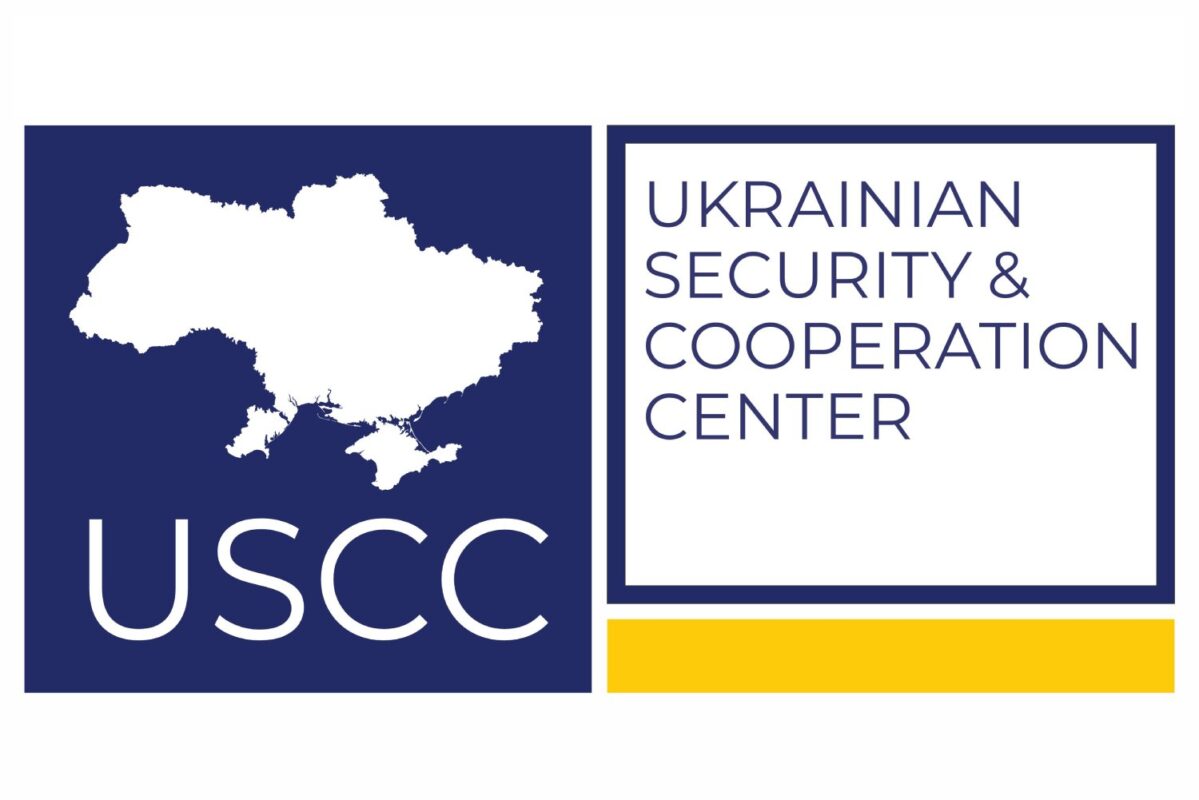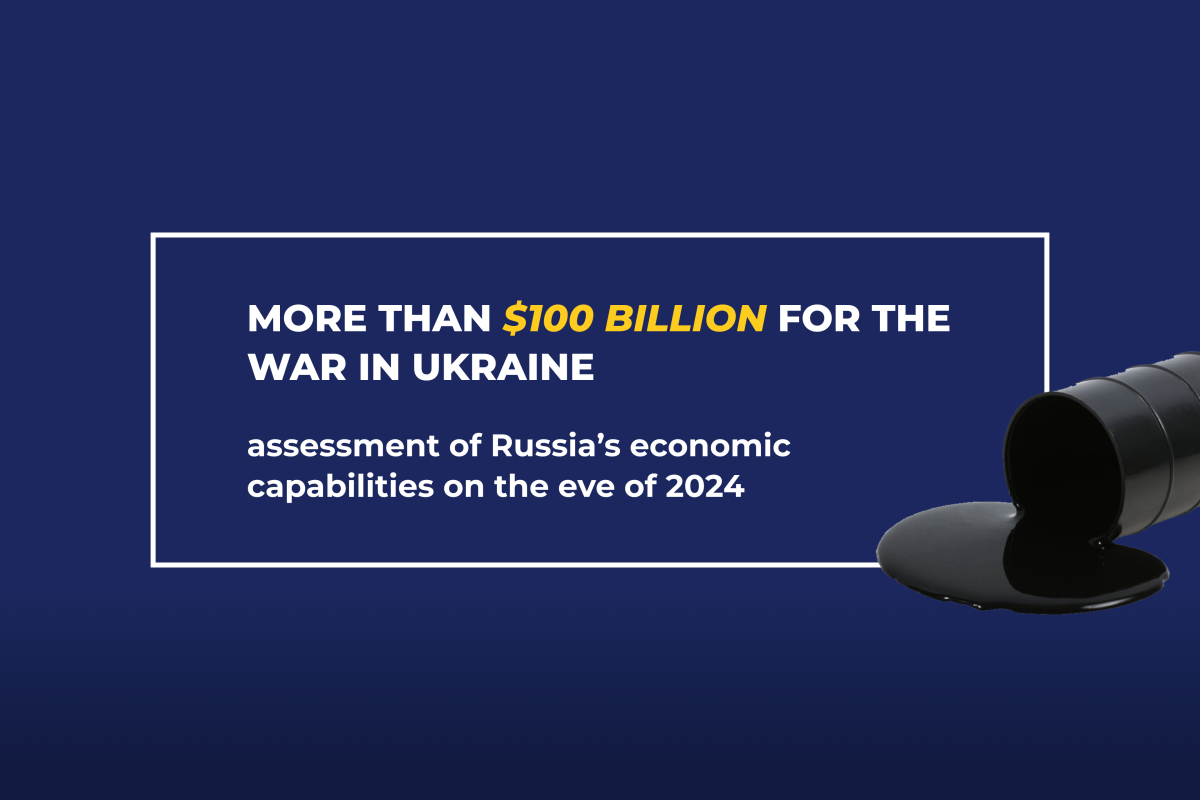Sanctions bypassing by Russia means more than $100 billion for the war in Ukraine. This amount is allocated for the army in the Russian budget for 2024. This amount is the biggest for Russia since the collapse of the Soviet Union. Despite the sanctions, the Russian economy is stabilizing and demonstrates its readiness to support a long-term war in Ukraine.
RESILIENCE OF THE RUSSIAN ECONOMY
In 2022-2023, unprecedented sanctions were imposed on Russia in many sectors of the economy, such as oil and gas, financial, technological and other. Such actions were supposed to reduce Russia’s financial capacity to wage war against Ukraine. The terrorist state should have faced the economic catastrophe.
Even according to Moscow’s forecasts, the Russian economy could have collapsed, but now the situation is stable. The indicators of the Russian economy show that the Kremlin has managed to keep the situation under control, rebuild and reorient its economic system to new realities. It also managed to increase spending on the war in Ukraine.
Since the beginning of the so-called “SMO”, the decline in Russian GDP in annual terms in 2022 amounted to 2.5%, and the budget deficit amounted to 3.3 trillion rubles, which is 2.2% of GDP. Despite the much worse performance compared to 2021, the decline in the Russian economy was not as sharp as international financial institutions had predicted.
Although Russia’s economy has significantly deteriorated compared to the previous year, 2021, Russia has come out of a steep decline. Not least due to record exports and oil and gas revenues, the Russian budget reached a record export of $591 billion. This should also include the usage of funds from the reserves of the Russian National Welfare Fund, which were used to cover the deficit.
At the same time, the Russian authorities started fruitful work on finding ways to circumvent the sanctions.
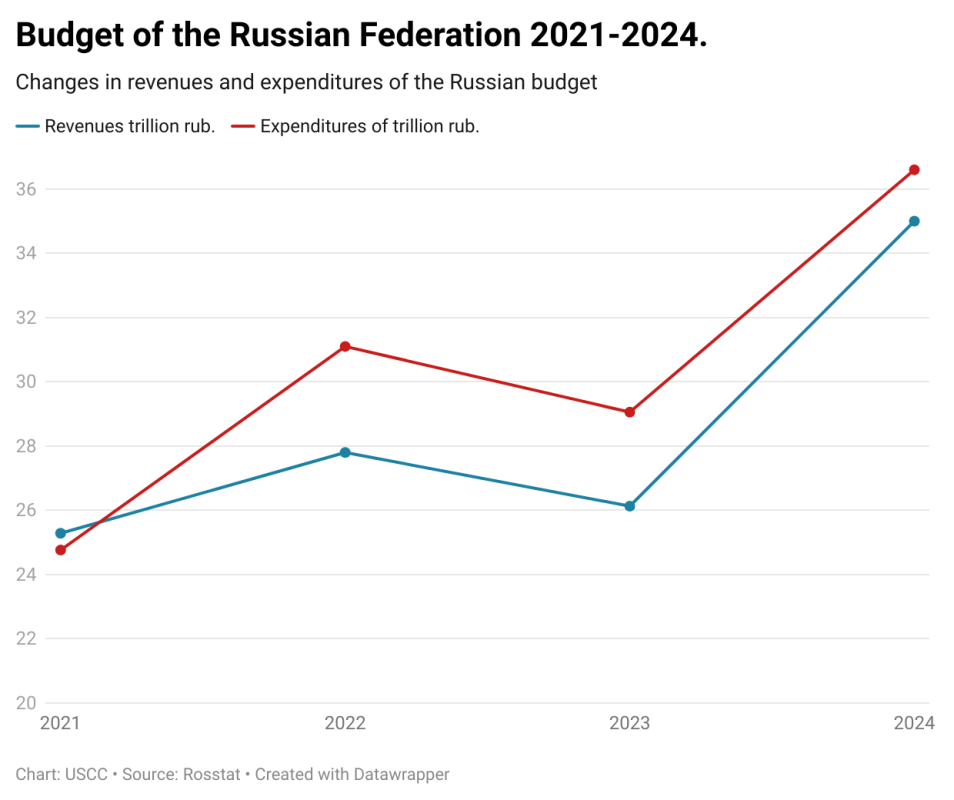
The international financial institutions (the International Monetary Fund, the World Bank, etc.) predict real GDP growth in Russia of 1.6-2.2% this year and 1.0-1.5% next year. As a result, although Russia started 2023 with significant financial difficulties, at the end of the year GDP growth of 3% is foreseen in Russia, and the budget deficit is around 1% of GDP. For example, in November 2023, Russia’s real GDP has already reached pre-war levels.
It is worth noting that gross domestic product is not the best economic indicator in a country at war and with a military-industrial complex geared to war. However, the Russian budget and its deficit can at least indicate Moscow’s ability to control financial risks and maintain budget replenishment.
Another clear indicator of the stabilization of the Russian economy is the activity indicators: industrial production, retail and the PMI (Purchasing Managers Index), which reflects the level of business activity in certain sectors of the economy. Russia’s PMI was critical only in the spring of 2022.
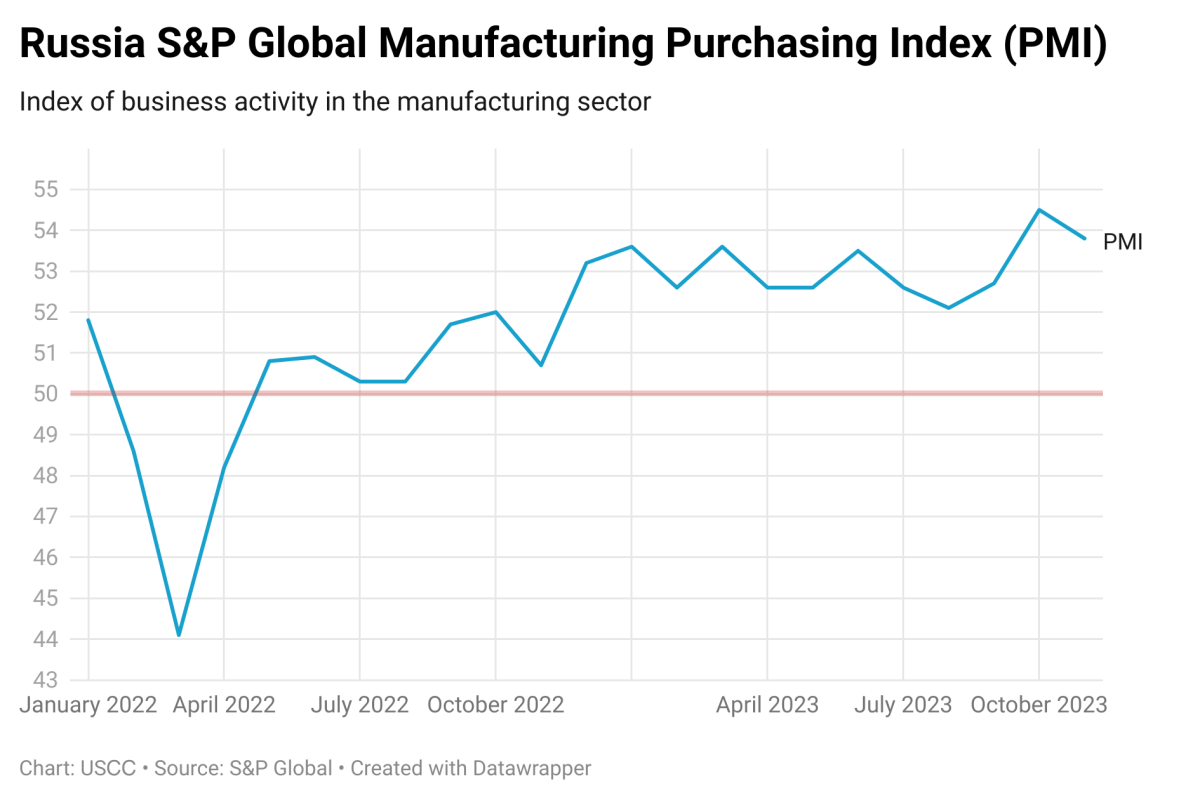
An index value of less than 50 indicates an economic downturn and a decrease in business activity
Variety of indicators make a consistent picture of the economic recovery from the 2022 recession, which has actually ended. In the last months of 2023, revenues from energy production, taxes and export duties recovered significantly, reaching the highest level since May 2022, as export revenues increased and the weaker ruble boosted their value in local currency. As a result, the federal budget deficit narrowed to RUB 1.7 trillion in January-September, which is broadly in line with the original budget plan for 2023.
The new budget, which has already been approved by the State Duma, envisages that in 2024, Russia’s revenues will grow by more than a third and reach 35 trillion rubles ($385 billion). Of these, 11.5 trillion rubles are expected in the oil and gas sector. The planned expenditures are 36.6 trillion rubles ($402 billion), which is 26.2% more than this year. This means that next year’s budget deficit, at least according to the government’s plans, should be significantly reduced – from the planned 2% of GDP in 2023 to 0.8% of GDP in 2024.
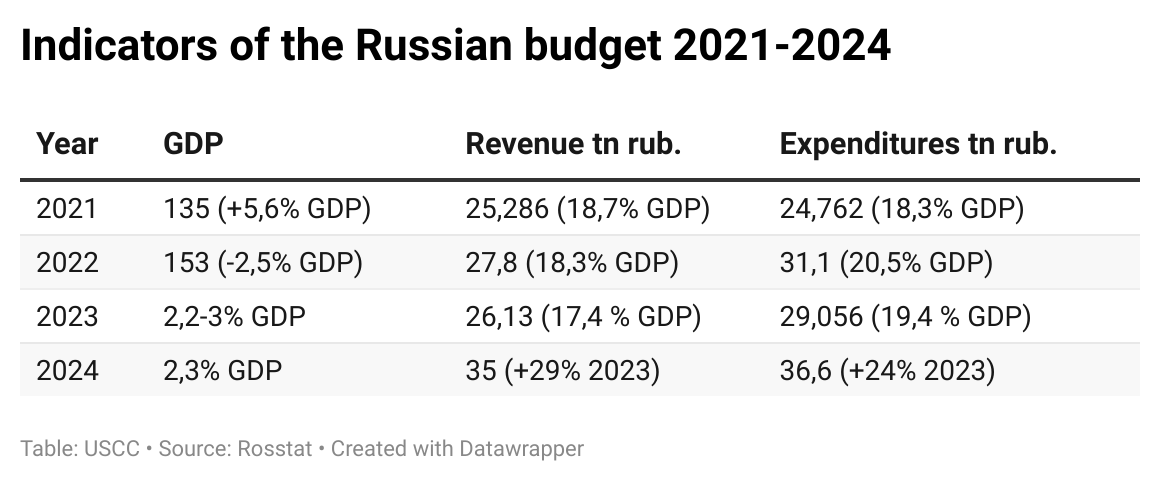
THE KREMLIN’S BUDGET IS FILLED WITH OIL
According to KSE experts, since February 2022, Russia’s losses from energy sanctions are estimated at $140-170 billion. The sanctions have led to a reduction in sales of Russian oil to Ukraine’s allies, an 80% drop in pipeline gas sales to Europe, and a significant decrease in sales of Russian oil to other countries. Although the energy sanctions have been effective, the Kremlin has found ways to circumvent them, including by increasing its shadow tanker fleet and reorienting exports. The figures for oil and gas revenues at the end of 2023 indicate that Russia has made a qualitative adjustment to the sanctions imposed by its Western allies.
The Kremlin has found new ways to sell oil by sea, which has significantly increased the volume of oil transportation to seaports in the Black Sea and the Far East, and by rail. The fact that in the first half of 2023, Russia produced 3.9 thousand tank cars, which is 2.1 times more than in the same period in 2022, is eloquent.
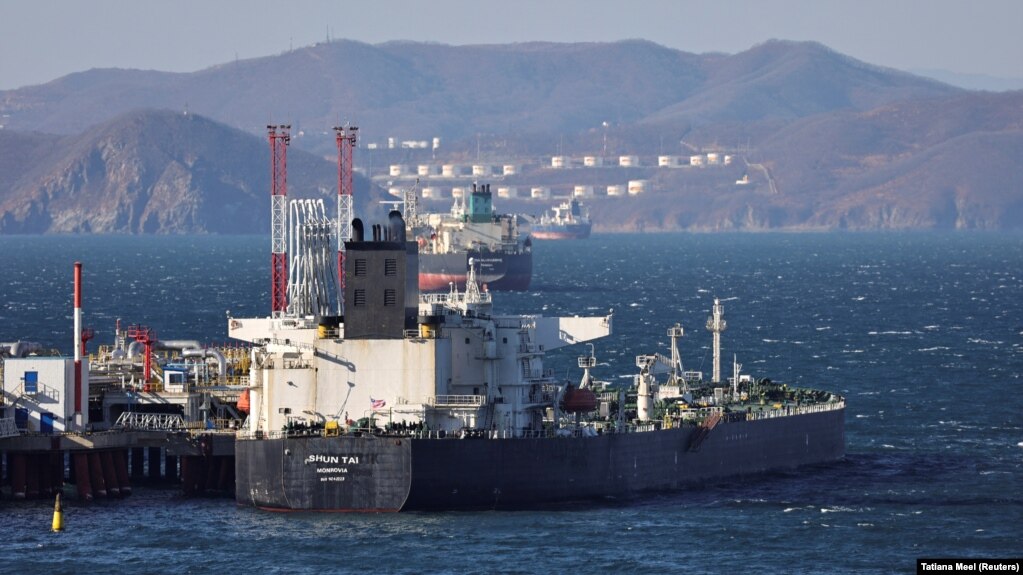
Russian terminal “Kozmino”. Source – Reuters
It is by rail that Russia has begun to transport oil more actively to the Kozmino sea terminal in Primorsky Krai, in the Far East. This is due to the lack of capacity of the Eastern Siberia-Pacific Ocean pipeline to export raw materials to China. Oil has not been supplied to Kozmino by rail since April 2016, and at the moment, the volume of supplies has increased by 100 thousand barrels per day only due to the railroad, bringing the total volume of supplies to 900 thousand barrels per day. “In 2023, Transneft expected to ship at least 40 million tons of oil through the Kozmino terminal.
According to the CREA research center, since the beginning of the full-scale invasion, Russia has received 551 billion euros in revenue from fossil fuel exports (oil – 378 billion, gas – 121 billion, coal – 51 billion). European Union countries imported raw materials worth more than 180 billion euros. After the sanctions restrictions on Russian energy imports to the EU, the Kremlin was able to redirect its oil exports to other markets, including significant growth in exports to China, India, and Turkey.
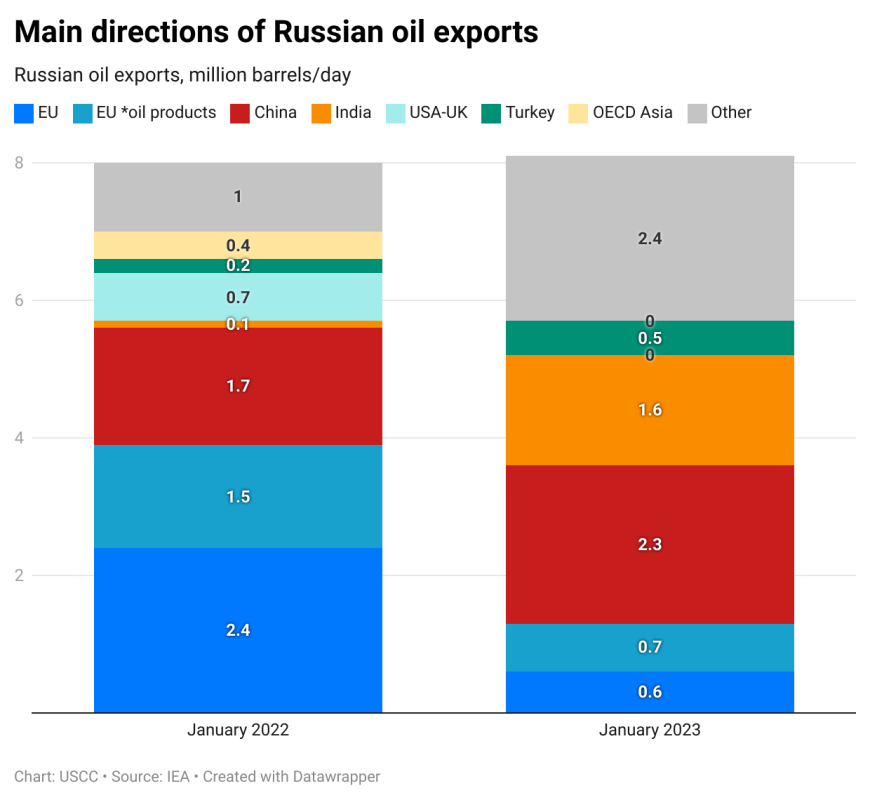
RUSSIA’S WAR ECONOMY
The Russian budget shows that Moscow plans to focus on financing the war in Ukraine by increasing spendings on it. This trend in the Russian budget has been observed since 2023.
Read also: WHAT’S NEXT: Assessment of Russia’s Military Capabilities on the Eve of 2024
According to the documents obtained by the media, in 2023, the Russian army and military-industrial complex will receive almost 10 trillion rubles ($106 billion) from the budget, which is three times more than before the war. This does not include spending on the security apparatus and other war-related needs, including construction projects in the occupied territories of Ukraine.
It is reported that in the first half of 2023, Russia exceeded the planned annual defense spending by 600 billion rubles more than planned for the whole of 2023. For the whole of 2023, spending on “national defense” was budgeted at 4.98 trillion rubles ($54 billion). For example, in Ukraine, expenditures for the entire security and defense sector for 2023 are set at UAH 1.4 trillion ($39.2 billion).
As already mentioned, in 2024 the Russian Ministry of Finance plans to significantly increase spending by 26.2% compared to 2023. As a result, in 2024, national defense and national security items will reach record levels. Officially, a record 10.7 trillion rubles ($117.7 billion) or 29.3% of budget expenditures (equivalent to 6% of GDP) is to be spent on military purposes next year. A year ago, the project for 2024 included 4.6 trillion rubles ($50.6 billion). To this should be added the expenditures in the adopted budget for national security in 2024 – 3.4 trillion rubles, or 9.2% of budget expenditures, and expenditures on closed items in 2024, for which the government is going to spend 11.0 trillion rubles, or 30% of total treasury expenditures. In addition, the Russian budget includes expenditures for the war in other items.
However, of course, the main items for waging war in Russia are “national defense”, “national security” and those items that the Russian authorities are carefully concealing.
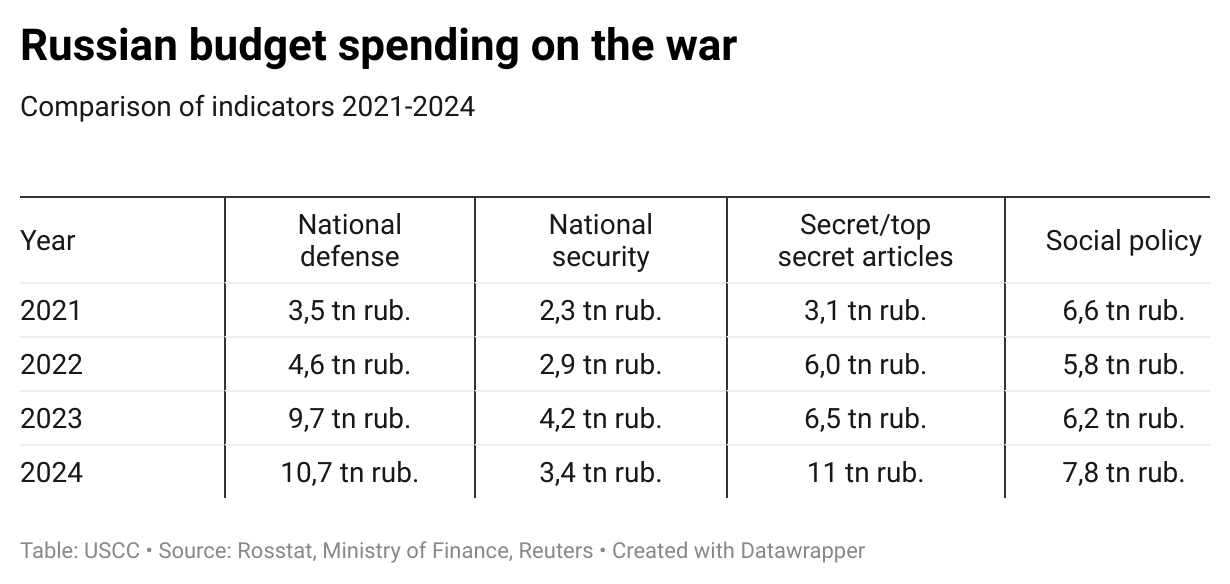
According to rough estimates, Russia plans to spend at least 25.1 trillion rubles ($276 billion), or 68.5% of the planned budget expenditures, on the security forces and the war in Ukraine only in 2024.
The transition to the Russian version of “military rails” is probably already underway, and 2024 will only be a continuation and strengthening of the orientation of the Russian economy towards the waging of an aggressive war in Ukraine. It can already be argued that the Kremlin has chosen a war of attrition, spending more and more money and opening up reserves to continue hostilities.
Even the Head of the Russian Ministry of Finance, Anton Siluanov, openly stated at a parliamentary hearing in the Federation Council that strengthening the country’s defense capabilities and “supporting the participants of the military special operation” is a priority of the Russian budget for the next three years.
SUMMARY
Macroeconomic indicators show that Russia has managed to stabilize its economy in the medium term since the full-scale invasion. Bypassing sanctions and selling oil by sea allows the Russian budget to be filled. As a result, expenditure items for the next 2024, including those related to the war in Ukraine, are growing at a record pace. The plans for the Russian budget, two-thirds of which are related to war expenditures, clearly show the reorientation of the Russian economy to wage a long-term war in Ukraine.
It is an undeniable fact that a prolonged focus on the war will significantly deplete financial, human, and other resources. This will have negative consequences for the Russian economy in the long run. However, for now, an analysis of Russia’s economic capabilities should encourage Western partners to impose tougher sanctions and stricter monitoring of compliance in order to deprive Russia of its tools of hybrid and political influence. And Ukraine should invest in its own defense and ability to resist the enemy.
